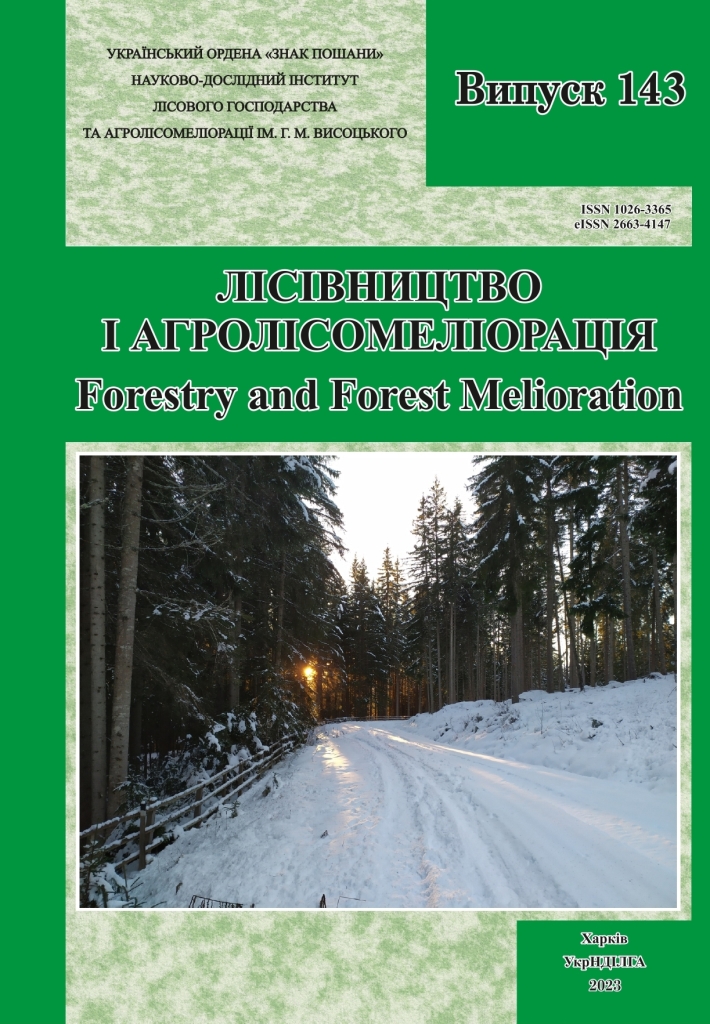Анотація
У Київському Поліссі однією з проблем лісовідновлення є потрава молодих рослин сосни звичайної дикими парнокопитними тваринами. Оцінено ефективність застосування репеленту «Цервакол Екстра» для захисту незімкнених культур сосни в ДП «Київська ЛНДС». На двох ділянках 30 ? 20 м окремо для кожної рослини дослідного й контрольного варіантів виявляли: наявність пошкодження лише верхівкового пагона, наявність пошкоджень верхівкового та бічних пагонів, відсутність пошкоджень. Також окомірно визначали частку пошкоджених пагонів кожної рослини – до 50 % та ? 50 %, а також частку рослин, які втратили спроможність до регенерації. Доведено, що у варіанті застосування репеленту «Цервакол Екстра» зменшується інтенсивність пошкодження пагонів сосни парнокопитними та частка рослин, що втратили спроможність до регенерації (p < 0,05). Частка рослин, пошкоджених парнокопитними у варіанті застосування репеленту, не перевищувала 6 %.
Посилання
Bergvall, U. A., Co, M., Bergstr?m, R., Sj?berg, P. J. R., Waldeback, M., Turner, C. 2013. Anti-browsing effects of birch bark extract on fallow deer. European Journal of Forest Research, 132: 717–725. https://doi.org/10.1007/s10342-013-0709-y
Bergvall, U. A. and Leimar, O. 2017. Directional associational plant defense from red deer (Cervus elaphus) foraging decisions. Ecosphere, 8: e01714-n/a. https://doi.org/10.1002/ecs2.1714
Bernacka, H., ?wi?cicka, N., Naworska, N. 2015. Application of sheep wool in preventing damage caused by deer in young forest plantations. Acta Scientiarum Polonorum Zootechnica, 14(4): 5–14.
D?mi??, K., Timma, S., Lazdi?a, D. 2021. Forest management practices in reduction of damage caused by pine weevil (Hylobius abietis L.) and Cervidae animals in newly planted Scots pine forests. EGU General Assembly 2021, online, 19–30 Apr 2021, EGU21-14555. https://doi.org/10.5194/egusphere-egu21-14555
Ecological passport of Kyiv region. 2021. Kyiv, Regional State Administration, 216 р. (in Ukrainian).
Faber, W. E. and Lavsund, S. 1999. Summer foraging on Scots pine Pinus sylvestris by moose Alces alces in Sweden – patterns and mechanisms. Wildl. Biol., 5: 93–106.
Felton, A. M., Wam, H. K., Stolter, C., Mathisen, K. M., Wallgren, M. 2018. The complexity of interacting nutritional drivers behind food selection, a review of northern cervids. Ecosphere, 9: 25. https://doi.org/10.1002/ecs2.2230
Fuchylo, Ya. D., Sbitna, M. V., Kaidyk, V. Yu., Riabukhin, O. Yu. 2012. Features of creation of Scots pine plantations in fresh subor conditions of Kyiv Polissya. Scientific Bulletin of UNFU, 22(13): 9–13 (in Ukrainian).
Gill, R. M. A. 1992. A Review of Damage by Mammals in North Temperate Forests: 3. Impact on Trees and Forests. Forestry: An International Journal of Forest Research, 65(4): 363–388. https://doi.org/10.1093/forestry/65.4.363-a
Honkanen, T., Haukioja, E., Suomela, J. 1994. Effects of simulated defoliation and debudding on needle and shoot growth in Scots pine (Pinus sylvestris): implications of plant source/sink relationships for plant-herbivore studies. Functional Ecology, 8(5): 631–639. https://doi.org/10.2307/2389926
Lapach, S. N., Chubenco, A. V., Babych, P. N. 2001. Statistical methods in biomedical research using Excel. Kyiv, Morion, 408 p. (in Russian).
Lindmark, M., Sunnerheim, K., Jonsson, B. G. 2020. Natural browsing repellent to protect Scots pine Pinus sylvestris from European moose Alces alces. Forest Ecology and Management, 474. https://doi.org/10.1016/j.foreco.2020.118347
Long, Z. T., Pendergast, T. H., Carson, W. P. 2007. The impact of deer on relationships between tree growth and mortality in an oldgrowth beech-maple forest. Forest Ecology and Management, 252: 230–238. https://doi.org/10.1016/j.foreco.2007.06.034
Nilsson, U., Berglund, M., Bergquist, J., Holmstr?m, H., Wallgren, M. 2016. Simulated effects of browsing on the production and economic values of Scots pine (Pinus sylvestris) stands. Scandinavian Journal of Forest Research, 31(3): 279–285. https://doi.org/10.1080/02827581.2015.1099728
Ostapenko, B. F. and Tkach, V. P. 2002. Forest typology. Kharkiv, Pleyada, 204 p. (in Ukrainian).
Perea, R. and Gil, L. 2014. Tree regeneration under high levels of wild ungulates: The use of chemically vs. physically-defended shrubs. Forest Ecology and Management, 312: 47–54. https://doi.org/10.1016/j.foreco.2013.10.022
Shadura, M. V., Gulyk, I. T., Shadura, A. M. 2004. Damage of forest plantations by wild boar (Sus scrofa L.) and roe-deer (Capreolus capreolus L.) on Polissya of Ukraine. Scientific Bulletin of UNFU, 14(8): 426–433 (in Ukrainian).
Stutz, R. S., Croak, B. M., Leimar, O., Alm Bergvall, U. 2017. Borrowed plant defences: Deterring browsers using a forestry by-product. Forest Ecology and Management, 390: 1–7. https://doi.org/10.1016/j.foreco.2017.01.013
Stutz, R. S., Pedersen, S., Ter?v?inen, M., Kjellander, P., Leimar, O.,· Verschuur, L., Bergvall, U. A. 2019. Efficient application of a browsing repellent: Can associational effects within and between plants be exploited? European Journal of Forest Research, 138: 253–262. https://doi.org/10.1007/s10342-019-01166-6
Vehvilainen, H. and Koricheva, J. 2006. Moose and vole browsing patterns in experimentally assembled pure and mixed forest stands. Ecography, 29: 497–506. https://doi.org/10.1111/j.0906-7590.2006.04457.x
Velamaz?n, M., San Miguel, A., Escribano, R., Perea, R. 2017. Threatened woody flora as an ecological indicator of large herbivore introductions. Biodiversity and Conservation, 26: 917–930. https://doi.org/10.1007/s10531-016-1279-3
Wallgren, M., Bergstr?m, R., Bergqvist, G., Olsson, M. 2013. Spatial distribution of browsing and tree damage by moose in young pine forests, with implications for the forest industry. Forest Ecology and Management, 305: 229–238. https://doi.org/10.1016/j.foreco.2013.05.057
Yevtushevskyi, M. M. 2008. The influence of deer on forest plantations. Bulletin of Zaporizhzhya National University. Biological sciences, 2: 59–63 (in Ukrainian).
Yevtushevskyi, M. М. and Piev, S. V. 2016. Protection of forest young plantations from damage by wild ungulates at the State Enterprise “Vovchansk Forestry” in Kharkiv Region. Scientific Bulletin of UNFU, 26(4): 64–71.

Ця робота ліцензується відповідно до Creative Commons Attribution 4.0 International License.
